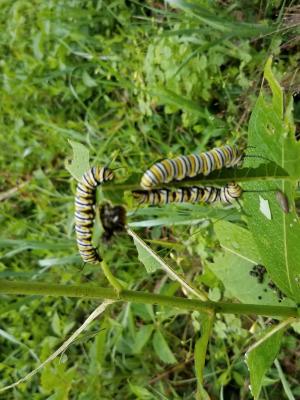Hail to the Kings and Queens of Butterflies
- Tags:
- Wildlife,
- Stewardship
Among the most fascinating facts about Monarch butterflies—while one generation of adult monarch will migrate south, it takes three or four generations to return. Photo by Jackie Sawyer
There’s an odd pleasure that comes from climbing on a tractor and mowing a field. You can measure your accomplishment of the task in the neat parallel tracks that the tractor lays out behind the bushhog. It speaks to the desire to impose your own sense of order on what can sometimes appear to be the random chaos of nature.
And around here if we want field habitat, we need to graze or mow. As the adage goes: How do you grow trees in New Hampshire? Just stop mowing. The field will become forest.

More recently, there has been broader recognition of the importance of milkweed to the proliferation of monarch butterflies, which have experienced significant declines in population. Thus, on the few acres of open field on our Tree Farm the mowing regimen has been altered again. Those neat mowed rows are interrupted as I direct the tractor around groupings of milkweed. I’ve seen the ‘milkweed swerve’ elsewhere in fields where it looks at first glance like the mower missed a few spots.
Milkweed is essentially the nursery for monarchs. After mating, mature monarchs seek out milkweed to lay eggs on the underside of the leaves. Monarchs have evolved to rely on milkweed for their very survival.
First, when the eggs hatch, the milkweed is a food source for the larvae (caterpillars). The caterpillars are immune to the mildly toxic nature of the milkweed plant, and by ingesting it they themselves become protectively toxic to other species that would otherwise make the monarch a tasty treat. The caterpillars become a pupa (chrysalis) before emerging as an adult butterfly. Their coloration is a warning to others—“eat me at your own risk”.

Adult monarchs don’t eat milkweed—they are important pollinators for a variety of other flowering plants.
The also migrate. The Eastern Monarch that we encounter in New Hampshire travels thousands of miles, at an average of five and a half miles per hour, south/southwest toward an into Mexico. (With our help, they’ve also even been to space, having been transported to the International Space Station and bred there.)
And among the most fascinating facts—while one generation of adult monarch will move south, it takes three or four generations to return. As they make their way back north, it is the offspring of each generation that continue the journey. How those great grandchildren know the migration route is not fully understood.
It’s become the fashion to breed monarchs by fostering the eggs and larvae indoors (in a jar on the porch, on a small scale). But some recent research indicates that monarchs don’t always end up with the same sense of direction when bred in such conditions—at least in larger quantities. In the study, butterflies raised indoors failed to fly south.
On the Forest Society’s Tom Rush Forest, we are managing the fields there to enhance common milkweed, which is being threatened by an invasive, black swallowwort. While black swallowwort is in the milkweed family, it is toxic or indedible for the monarch caterpillars and they don’t survive, and the swallowwort displaces common milkweed.
So next time you climb on the tractor or lawn tractor to satisfy an urge to bring order to nature, take a moment to look more closely at what might be in your path. The fate of a few hundred butterflies may be in your hands.
Jack Savage is the Executive Editor of Forest Notes, the quarterly magazine of the Society for the Protection of New Hampshire Forests. To find out more about the Forest Society, visit www.forestsociety.org.
